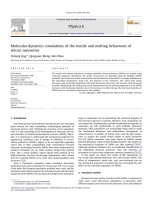- Trang chủ >>
- Khoa Học Tự Nhiên >>
- Vật lý
Nature of the band gap of silicon and germanium nanowires
Bạn đang xem bản rút gọn của tài liệu. Xem và tải ngay bản đầy đủ của tài liệu tại đây (196.79 KB, 5 trang )
Physica E 32 (2006) 341–345
Nature of the band gap of silicon and germanium nanowires
Clive Harris, E.P. O’Reilly
Ã
Tyndall National Institute, Lee Maltings, Cork, Ireland
Available online 8 February 2006
Abstract
Nanowires of both Si and Ge have been predicted to have band gaps that are either direct or indirect depending upon the
crystallographic direction along which the nanowire is oriented. We use a sp
3
d
5
s
Ã
tight binding model to calculate the band structures for
both Ge and Si nanowires oriented along the (1 0 0), (1 1 0) and (1 1 1) directions. We show that the nature of the band gap and the
variation of the zone centre band gap with nanowire width depends upon the nanowire stacking direction for both Si and Ge nanowires.
We then show, by considering bulk unit cells along the (1 0 0), (1 1 0) and (1 1 1) directions, that it is possible to accurately predict whether
a nanowire stacked in the same direction as one of these bulk unit cells has a direct or indirect band structure.
r 2006 Elsevier B.V. All rights reserved.
PACS: 73.21.Hb; 73.20.At
Keywords: Nanowires; Band structure; Silicon; Germanium
1. Introduction
A path towards the integration of optically and
electrically active material was opened when nanostruc-
tured silicon (Si) was found to exhibit strong photolumi-
nescence [1]. The integration of optically active Si with
electrically active Si would allow both optical and electrical
processes to occur on the same chip and would further
open the mature Si processing industry to optical devices
[2]. From a compatibility point of view, germanium (Ge) is
also a promising candidate for direct integration with
existing Si technology. Noting this, the possibility of
integrating optically active nanostructured Ge [3] with Si
technology could also be important.
The optical properties of both Si and Ge nanowires have
been experimentally studied [4,5]. Differing luminescence
properties have been observed for Si nanowires grown
along different crystallographic axes [4]. From a theoretical
perspective, the band structure of Si nanowires has been
more widely studied [6,7] than that of Ge [8]. These
theoretical studies showed that the nanowire energy gap
could be either direct or indirect, depending upon the
crystallographic orientation of the nanowire.
We use an sp
3
d
5
s
Ã
tight–binding (TB) model here to
study the electronic structure of crystalline Ge and Si
nanowires, varying in width from $10
˚
A to over 60 A
˚
.We
examine the variation of the direct band gap with width, as
well as the nature of the band structure of the nanowires.
We confirm previous observations ab out the direct or
indirect nature of the nanowires, while also extending these
previous observations in Ge [8] to larger nanowire sizes.
We explain the nature of the bandgap for both materials,
using an argument based upon the bulk band structure of
these materials projected onto the crystallographic axes,
(1 0 0), (1 1 0), (1 1 1). We confirm that an effective mass
approximation (EMA) gives a good description of the
conduction band (CB) energy for Si nanowires down to
$20
˚
A in size [9] but show that the CB EMA breaks down
for Ge nanowires that are $50
˚
A.
2. Nanowire electronic structure
We present here the electronic structure for both Si and
Ge nanowires, oriented along the (1 0 0), (1 1 0) and (1 1 1)
directions, calculated using a sp
3
d
5
s
Ã
TB Hamiltonian [10].
We add hydrogen (H) atoms to the nanowire surfaces to
ARTICLE IN PRESS
www.elsevier.com/locate/physe
1386-9477/$ - see front matter r 2006 Elsevier B.V. All rights reserved.
doi:10.1016/j.physe.2005.12.094
Ã
Corresponding author.
E-mail address: (E.P. O’Reilly).
maintain the original tetrahedral bond angles and coordi-
nation of the bulk material. We construct all of the
nanowires with a square cro ss-section. The TB parameters
for Si–Si and Ge–Ge interactions are taken from [11]. The
valence band (VB) maximum for bulk Ge and Si is rescaled
to be at 0 eV. The Si–H and the Ge–H TB parameters were
calculated from fits to SiH
4
and GeH
4
molecules, with the
bond lengths taken to be 1.48 A
˚
and 1.52 A
˚
, respectively.
Fig. 1 shows the variation with nanowire size of the band
gap at the Brilluoin zone centre for nanowires stacked
along each of the three crystallographic directions.
The band gap increases with decreasing nanowire width,
and different direct energy gaps are found for differently
oriented nanowires of sim ilar width, in agreement with
previous calculations [8,12]. We find for the zone centre
energy gap in Ge that E
100
g
4E
111
g
4E
110
g
, whereas in Si
E
100
g
4E
111
g
’ E
110
g
.
As the nanowire width D increases, the difference
between the Ge (1 0 0) and Ge (1 1 0) energy gap remains
almost constant (up to at least 60 A
˚
). The difference
between the Si (1 0 0) and Si (1 1 0) energy gap decreases
with D. The band gap for Si nanowires oriented along all
three directions is converging towards the G2X bulk band
gap. The Ge nanowires converge towards different band
gaps: (1 1 0) towards the G 2L gap, whereas (1 0 0) and
(1 1 1) nanowires converge towards the G2X value.
Figs. 2 and 3 show the band dispersion along the
nanowire direction for Si and Ge nanowires with D$20
˚
A.
The Si nanowires maintain a direct band gap, while the Ge
nanowires are only direct when stacked along (1 1 0). This
is true for all nanowire widths considered here. This is
likely to limit the use of ideal Ge nanowires for the efficient
production of light. Overall, the effect of the internal
stacking of the nanowire is two-fold. It influences the size
ARTICLE IN PRESS
1
2
3
4
Energy/eV
(100)
(110)
(111)
0 102030405060
Width/Å Width/Å
0 102030405060
1
2
3
4
Energy/eV
(100)
(110)
(111)
(a) (b)
Fig. 1. Variation of zone centre band gap with respect to nanowire width for nanowires oriented along (1 0 0), (1 1 0) and (1 1 1) in (a) Si and (b) Ge.
Increasing K Increasing K Increasing K
0
1
Energy/eV
-1
2
0
1
-1
2
0
1
-1
2
Fig. 2. Band structure of (1 0 0), (1 1 0) and (1 1 1) Si nanowires with D$20
˚
A.
C. Harris, E.P. O’Reilly / Physica E 32 (2006) 341–345342
of the band gap and determines the overall nature of the
nanowire band structure.
3. Effective mass approximation
The CB e nergy of a nanowire o f cro ss-sectional area D Â D
can be written using an effective mass approximation as
E
c
¼ E
c0
þ
h
2
8D
2
1
m
Ã
x
þ
1
m
Ã
y
!
, (1)
where m
Ã
x
and m
Ã
y
are the effective masses in the x and y
directions within the nanowire, with the nanowire axis set
along z. Taking the bulk unit cells in Section 4 to represent
each nanowire direction, the effective mass values can be
readily calculated for each of the indivi dual nanowire
stacking directions. From these, the EMA is found to
predict the CB energy for Si nanowires down to
approximately. 20–30 A
˚
in width as previously seen [9].In
the Ge case the EMA is found to break down at much
larger nanowire widths. The EMA method fails to predict
the CB energy for Ge nanowires under D$50
˚
A (see Fig. 4).
The low value of the transverse effective mass (m
Ã
t
) leads
the EMA to predict a rapid increase of the CB energy with
decreasing nanowire size. However interactions with higher
conduction bands push the CB edge down, leading to the
breakdown of the EMA.
4. Dependence of nanowire band structure on bulk band
structure
We show here how the direct or indirect nature of the
nanowire band gap can be predicted from the bulk band
structure.
ARTICLE IN PRESS
Increasing K Increasing KIncreasing K
0
-1
1
Energy/eV
2
0
-1
1
2
0
-1
1
2
Fig. 3. Band structure of (1 0 0), (1 1 0) and (1 1 1) Ge nanowires with D$20
˚
A.
Ge (110)
Ge (111)
Width/Å
Energy/eV
Si (100)
Si (110)
Ge (100)
Si (111)
5
4
3
2
1
4
3
2
1
4
3
2
1
4
3
2
1
Energy/eV
5
4
3
2
1
Energy/eV
5
4
3
2
1
10 20 30 40 50 60 70 80 90
Width/Å
10 20 30 40 50 60 70 80 90
Fig. 4. Comparison of the zone centre CB energy calculated using the
EMA (solid line) and a sp
3
d
5
s
Ã
TB model (dotted line).
C. Harris, E.P. O’Reilly / Physica E 32 (2006) 341–345 343
The bulk diamond crystal structure can also be
represented by unit cells oriented in the (1 0 0), (1 1 0) and
(1 1 1) directions. These are constructed by finding the
minimum repeat lattice vector a
1
in each direction which is
formed from a combination of the primitive lattice basis
vectors a
1
, a
2
, a
3
, and then finding two lattice vectors
ða
2
; a
3
Þ perpendicular to a
1
which are also constructed from
a
1
, a
2
and a
3
. The bulk unit cell vectors for the three
directions of interest here are shown in Table 1, with the
unit cell size a set equal to 1.
An ideal (1 0 0) nanowire is constructed by repeating
layers of (1 0 0)-oriented unit cells. Fig. 5 below shows the
reduced Brillouin zone for a (1 0 0) supercell. The bulk
states in the plane A provide a complete basis from which
to construct the zone centre nanowire states, while the bulk
states on plane B provide a complete basis from which to
construct the states at the nanowire zone edge. Therefore, if
the CB minimum in plane A is at a lower energy than the
CB minimum in plane B we can expect the nanowire CB
minimum to be at the centre (G point) of the nanowire 1D
Brillouin zone. Similarly, if the CB minimum for plane B is
lower than the CB minimum for plane A, the nanowire
would be indirect in nature.
Although only illustrated here for (1 0 0)-oriented
nanowires, this argument is also valid for the other two
stacking directions which we are considering.
Examining the band structure of (1 0 0), (1 1 0) and (1 1 1)
bulk unit cells, we can then use the above argument to
determine whether the overall energy gap is direct or
indirect. Table 2 shows the distribution of the G, X and L
states between the A and B planes in the (1 0 0), (1 1 0) and
(1 1 1) unit cells. In the (1 0 0) and (1 1 1) bulk uni t cells, the
X ðLÞ points are clearly on the A (B) plane. This explains
why the Si (1 0 0) and (1 1 1) nanowires are direct in nature,
whereas the Ge (1 0 0) and (1 1 1) nanowires have an
indirect gap. For the (1 1 0) case, effective mass arguments
are required to explain the nature of the energy gap in the
associated nanowire.
In bulk material the CB minimum for Si lies along the six
equivalent X directions, whereas the Ge CB minimum lies
at the four L points within the primitive Brilluoin zone.
For the (1 1 0) case, it can be seen that the X and L
symmetry points lie on both the A and B planes. So it is
necessary to assess on which plane the L states are more
tightly confined, and hence at a lower energy. States with
higher effe ctive masses are more tightly confined. We
calculate for bulk Ge a longitudinal mass of m
Ã
l
¼ 1 : 6m
0
along G2L near the L point and a much smaller transverse
mass m
Ã
t
¼ 0 : 1m
0
, similar to typical calculated values [11].
When we calculate the effective mass around the L states
on the A plane in Ge, we find that the effective mass varies
from 0:1m
0
to 1:6m
0
, whereas the B plane mass varies from
0.1m
0
to 0.25m
0
. We therefore conclude that the L states on
the A plane in the (1 1 0) Ge nanowire should be at a lower
energy than those on the B plane. Hence, the CB minimum
in Ge (1 1 0) nanowires will be at G.
Using a similar analysis, we find that the X states on the
A plane in a Si (1 1 0) nanowire are more tightly confined
than those on the B plane, so that the CB minimum in Si
(1 1 0) nanowires will also be at G.
5. Conclusion
We have presented the band structure of Ge and Si
nanowires oriented along the (1 0 0), (1 1 0) and (1 1 1)
crystallographic directions. We find that the zone centre
band gap in all three types of Si nanowire converges
towards the G2X bulk band gap, whereas the zone centre
band gaps for (1 0 0) and (1 1 0) Ge nanowires clearly
converge to different bulk band gap values. The (1 0 0) gap
converges towards the G2X band gap, while the (1 1 0)
nanowire converges towards the narrower G2L band gap.
ARTICLE IN PRESS
Table 1
Lattice vectors (a
0
s) and reciprocal lattice vectors (b
0
s) for the bulk unit
cells (a) (1 0 0), (b) (1 1 0) and (c) (1 1 1)
(1 0 0) (1 1 0) (1 1 1)
a
1
(1,0,0) (1/2,1/2,0) (1,1,1)
a
2
(0,1,0) ð1=2; À1=2; 0Þð1=2; 0; À1=2Þ
a
3
(0,0,1) (0,0,1) ð0; 1=2; À1=2Þ
b
1
2p/a(1,0,0) 2p/a(1,1,0) 2p/að1=3; 1=3; 1=3Þ
b
2
2p/a(0,1,0) 2p/að1; À1; 0Þ 2p/að4=3; À2=3; À2=3Þ
b
3
2p/a(0,0,1) 2p/a(0,0,1) 2p/aðÀ2=3; 4=3; À2=3Þ
(001)
(010)
B
A
(100)
Γ
X
Fig. 5. Representation of the (1 0 0) Brillouin zone for a bulk, with the
gamma point marked and the zone edge along (1 0 0) marked as X, two
planes A and B are also shown.
Table 2
The plane on which the G, X and L primitive unit cell points lie in the 3
cells (1 0 0), (1 1 0) and (1 1 1)
Bulk (1 0 0) (1 1 0) (1 1 1)
G AAA
X AABA
L BABB
C. Harris, E.P. O’Reilly / Physica E 32 (2006) 341–345344
This can be clearly understood based on the conduction
band level ordering in Si and Ge. The full band structures
therefore shows Si nanowires to be direct while Ge
nanowires are only direct when stacked along the (1 1 0)
direction. We conclude that it should be possible to predict
the nature of the band gap of a nanowire oriented along
any other direction by also investigating the band
dispersion in a bulk unit cell oriented along the nanowire
direction.
Acknowledgments
We thank Science Foundation Ireland for funding this
work, and Simon Elliott, Justin Holmes and Guillaume
Audoit for useful discussions.
References
[1] L.T. Canham, Appl. Phys. Lett. 57 (1990) 1046.
[2] H. Rong, et al., Nature 03273 (2005).
[3] M. Zacharias, P.M. Fauchet, Appl. Phys. Lett. 71 (1997) 380.
[4] J.D. Holmes, et al., Science 287 (2000) 1471.
[5] N.R.B. Coleman, et al., Chem. Phys. Lett. 343 (2001) 1–6.
[6] U. Schmid, N.E. Christensen, M. Alouani, M. Cardona, Phys. Rev. B
43 (1991) 14597.
[7] M.S. Hybertsen, M. Schluter, Phys. Rev. B 36 (1987) 9683.
[8] A.N. Kholod, et al., Phys. Rev. B 70 (2004) 035317.
[9] C Y. Yeh, S.B. Zhang, A. Zunger, Phys. Rev. B 50 (1994) 14405.
[10] J.M. Jancu, et al., Phys. Rev. B 57 (1998) 6493.
[11] T.B. Boykin, G. Klimeck, F. Oyafuso, Phys. Rev. B 69 (2004) 115201.
[12] G.D. Sanders, Y C. Chang, Phys. Rev. B 45 (1992) 9202.
ARTICLE IN PRESS
C. Harris, E.P. O’Reilly / Physica E 32 (2006) 341–345 345









